|
|
Post by Lee Martin on Jan 17, 2024 17:32:38 GMT -5
Match #187 Black Creek Gun Club – Mechanicsville, VA IBS 100 Yard VFS The third match of our Black Creek winter league almost didn’t happen. Earlier in the week, they were calling for ice and snow. That changed however by Friday, with the forecast being downgraded to rain and wind. We arrived at the range just before 7:00 and waited for the staff to open the main gate. By 7:30 there were only five of there…and that seemed odd. At 8:30, Wayne Wadlington called one of the managers to find they had closed the range. The decision was made earlier in the week when ice and snow were in the mix. Fortunately, the owner came and opened the place up for us. No matter what the weatherman said, the conditions weren’t bad. Wind was 5 – 10 mph, so you had to watch it. The rain was light up until the end. Then the skies flooded us with heavy rain. We shot through what could only be described as odd air. Many times, the flags would show left to right blow, but the bullets would print left. That forced a few of us to hold right on right wind. Pretty unnerving really. Basically, we were holding into the condition. I lost a few X’s by not holding enough right. But again, the wind was blowing right. It was tough to trust that POA. I sure as hell didn’t want to land a 9. Wayne France figured it out better than I and took the win. I came in 2nd.  ______________________________________________________________ Match #188 Fairfax Rod & Gun Club – Manassas, VA UBR 200 Yard VFS Our 3rd FR&GC winter league match at 200 yards dealt some nasty weather. The skies were dry, the temps were a blustery 30 something, and the wind was fierce. It changed constantly with gusts of 20 mph. At one point I noticed leaves in the field swirling like a mini-tornado. I found something that worked well though. I’d let the wind blow hard right to left and just as the tails would relax from 9:00 to say 7:00, I held on the outside of the 10 ring at 4:00 and let the bullet go. Towards the end, we started getting left-to-right that wouldn’t go away. I tested the sighter and found a 9:00 hold on the 10-ring worked beautifully. Again, I waited until the tails started to fall from 3:00 to about 5:00. Going into the last frame, I had stout 5-point lead. But in wind like that, the lead could evaporate quickly. Lots of 7’s and 8’s had been shot by others throughout the morning. The first three bulls hit the X, and that gave me confidence. I shot the last three and stayed on the 10. That was good enough for my second straight win at Fairfax. 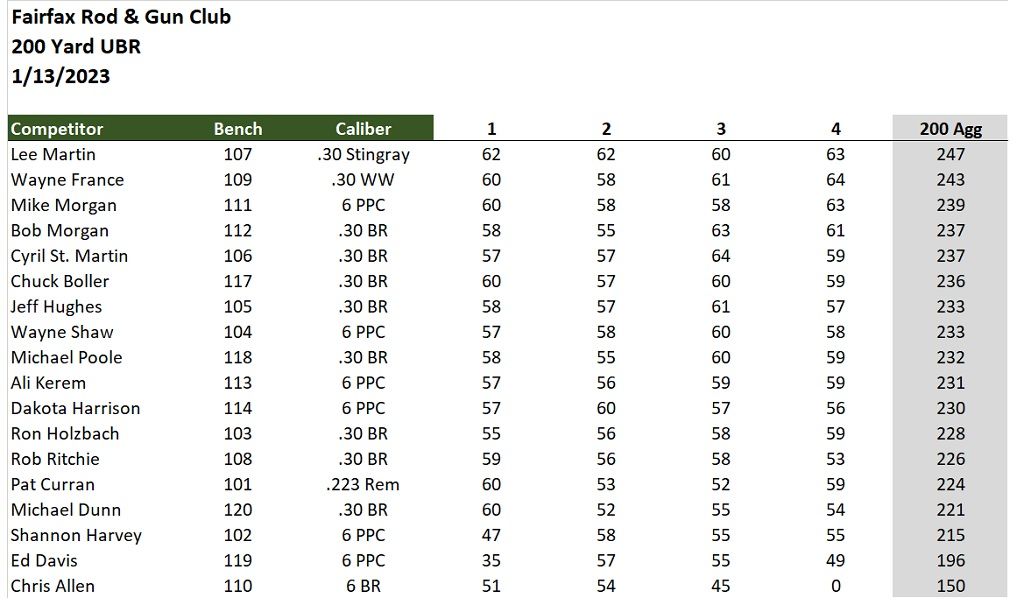 -Lee www.singleactions.com"Chasing perfection five shots at a time" |
|
|
|
Post by bradshaw on Feb 7, 2024 13:54:30 GMT -5
Notice the bench rest game to obliterate a pencil point. It takes the same bench rifles which define the one-hole game, wherein the object is to plant 4 more shots through the first hole----each bullet riding a single axis.
The scoring differs, and the sighting differs. The game played bye Lee and fellow bench resters is to erase the pencil point, one bullet per pencil point. In this game, the value of the tiny dot lasts one shot. Then it is time to shift the rifle to next pencil point. Because it takes just one shot to wipe out the pencil point, a different dot must be available for the next shot. And so on, until the required number of targets is accounted for.
The two most direct scoring systems in marksmanship are 1) bench rest fired for group, wherein group size measured in 1/1,000" = score. And, and 2) metallic silhouette, where in correct sequence, the steel target falls from its stand, or not. One target toppled = 1 point. One target still standing = 0 point.
I suspect a comparison of bench rest games----group size vs score----would show tighter measurements from group shooters. The reason is Country Simple, the groups shooter isn’t concerned with a target: the “target” is to fit five shots in the size of one, then repeat it, agains & again. On the other hand, the “X” shooter aims to obliterate a dot, an utterly exact target. Both bench rest shooters SHOOT CONDITIONS, first and foremost wind, secondarily light and humidity. Those who do their shooting on the Firing Line know conditions incorporate mirage.
The wallet shooter whose rifle groups a quarter or half inch “all day long,” lives in a cloud “all day long.” Having never been there, he mistakes his cloud for "being in the Zone,” when he shoots. “ The Zone” as perpetual space shared with saints. Hate to stab this balloon, but nobody lives in "the Zone," not even saints. Technique, practice, determination, and talent equip a sharpshooter. Those who visit the Zone probably don’t know it until they’re off the Firing Line. If they do notice, it’s a whip of self-criticism to tighten-up and continue. Closest thing to the Zone is Living in the Present, neither a quarter-second in the past, nor a quarter second in the future at hammer fall. That’s where the target is made.
David Bradshaw
|
|
|
|
Post by Lee Martin on Mar 1, 2024 18:49:49 GMT -5
Match #189 Black Creek Gun Club – Mechanicsville, VA IBS 100 Yard VFS This was the fourth of five Black Creek Winter League matches. We had another great turnout with very manageable conditions. Even so, I and others struggled to hit high X counts. Before we started, I figured it would take well over 20 X’s to win. Oddly, only one shooter out of 24 even got to 20. And that person was Alex Oliveri. He’s less than two years into the sport and this was his first victory. We were all happy for him. He's a nice guy and shows a ton of promise in the sport. 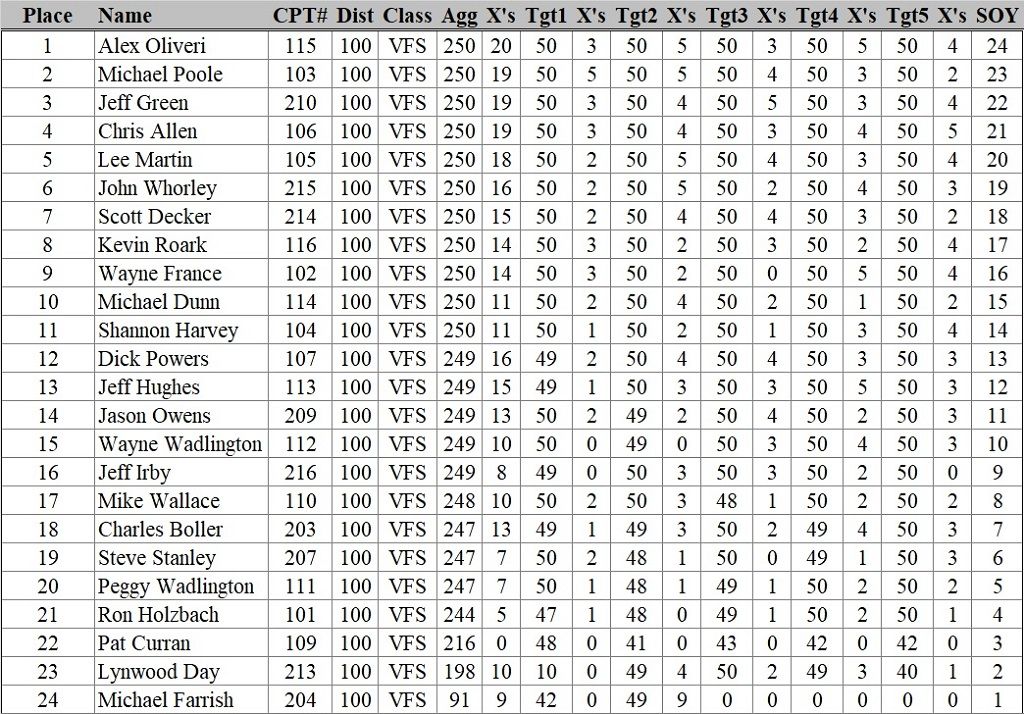 A view of the firing line:  _______________________________________________________________ Match #190 Fairfax Rod & Gun Club – Manassas, VA UBR 200 Yard VFS The weatherman called for light wind and mild temperatures and that’s exactly what we got. The prior month I won the match using two holds in very hard wind. The game plan was to do the same for this match. If it worked in harsh conditions, it should in mild, right? Well, it didn’t. I shot OK but couldn’t get the X count like I had in January. I did well enough to place 4th out of 18 competitors. Dick Powers looked like he had it won going into the last frame but trailed off a little. That gave Cyril St. Martin enough room for the win. Dick finished 2nd and Wayne France was 3rd. |
|
|
|
Post by Lee Martin on Mar 14, 2024 18:38:32 GMT -5
Match #191 Black Creek Gun Club – Mechanicsville, VA IBS 100 Yard VFS This was the fifth and final match of our 2023/24 Black Creek Winter League. In case I haven’t covered the format in previous posts, here’s how it works. We shoot five matches between November and March at Black Creek, 100 Yards. We do the same at Fairfax Rod & Gun Club, except that’s 200 yards under UBR sanctioning. At the end, the best 4 out of 5 match scores are added together per competitor. The highest cumulative score wins the championship. Going into Black Creek and Fairfax’s final match, I had the lead with both. Black Creek dealt us mild wind by heavy rain throughout. Early on, it was dumping buckets. Scoring soggy targets wasn’t easy, but I muddled through it. I shot well, hitting 22X’s in total. On the 2nd and 3rd frames, my X counts slipped and I couldn’t figure out why. Then I realized I hadn’t pounded the butt of the gun into the rear bag after each relay (something I always do to prevent it from riding up in the ears). The gun went right back to shooting 5 X targets on the 4th and 5th frames. The big story of the day however was Jason Owens. He hit all 25X’s, which is extremely hard to do. The targets have been sent off to the IBS records committe for confirmation. He has 1 X which is close. Myself and three referees reticled it and felt it made. But it’s close enough it may not pass record committee review. Fingers crossed. My 5th place finish was enough to secure my 4th straight Black Creek Winter League Championship (and I’ve taken 5 of the last 6). I’m proud of this because these championships require a high degree of consistency. Results with the winter league top 10 (we had 29 shooters in all from November to March):  It was a wet day! 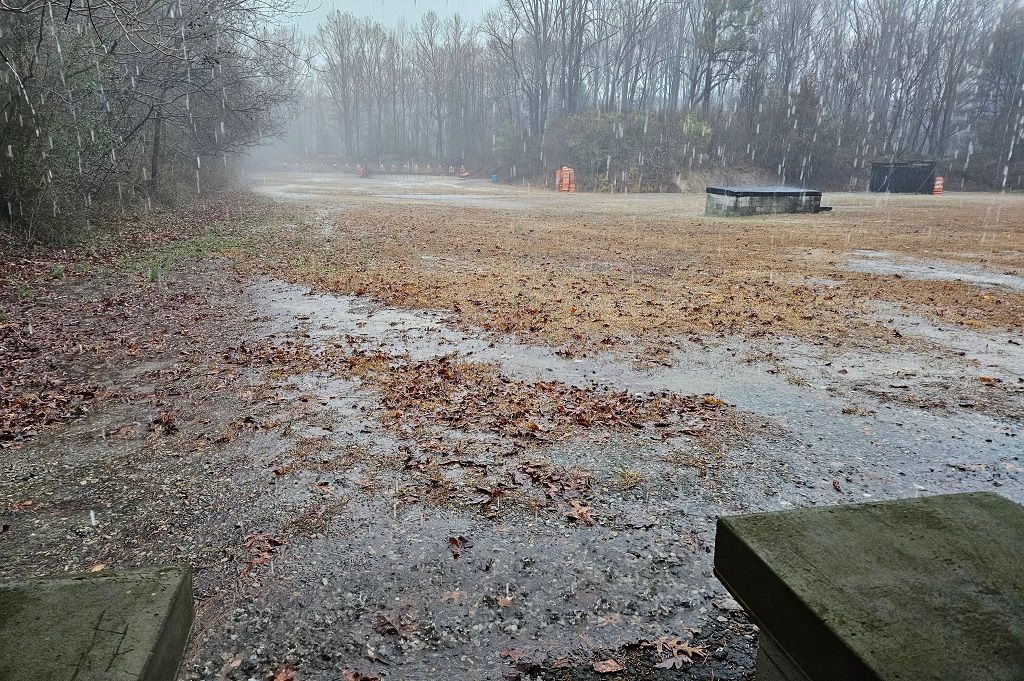 Jason Owens with his potential 250-25X targets: 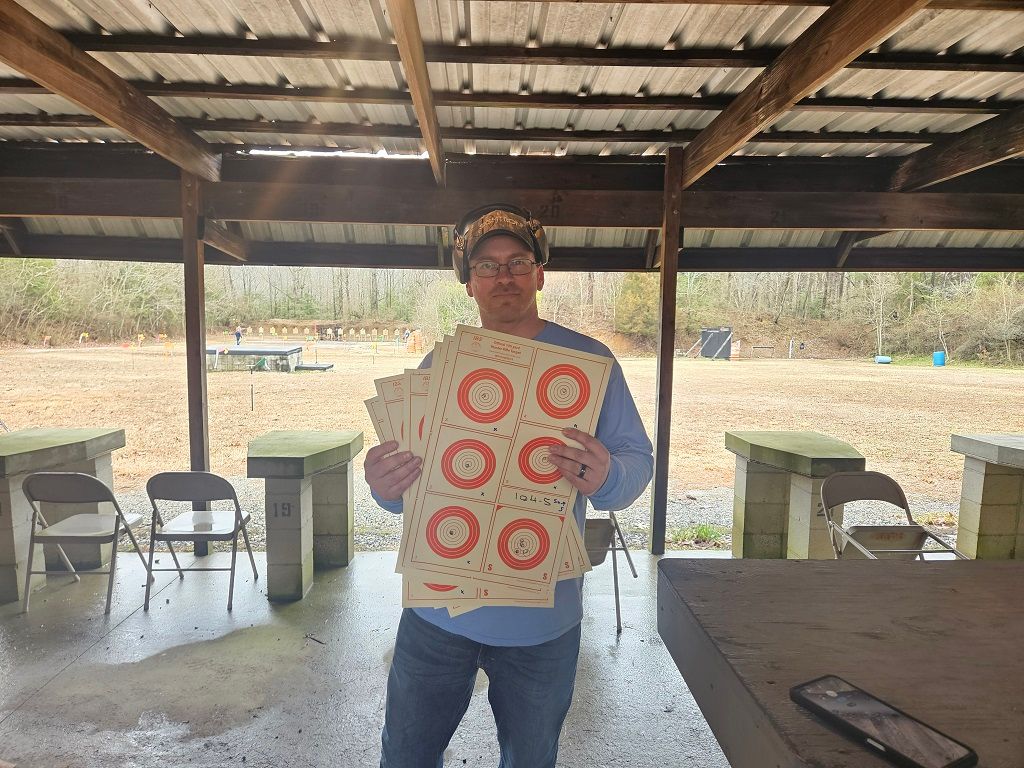 __________________________________________________________________ Match #192 Fairfax Rod & Gun Club – Manassas, VA UBR 200 Yard VFS Like Black Creek, I went into the final Winter League match with a decent lead in the championship standings. Wayne France and Chuck Boller had a chance of catching me, but it would take some high scores. The wind wasn’t as bad as predicted. We were supposed to get 15+ mph blow, but aside from brief moments, that never materialized. I shot good and finished in 2nd place. John Whorley was on a line and took the day with a 4 point gap on my 2nd. I was solid enough however to secure my 3rd straight Fairfax Winter League Championship. 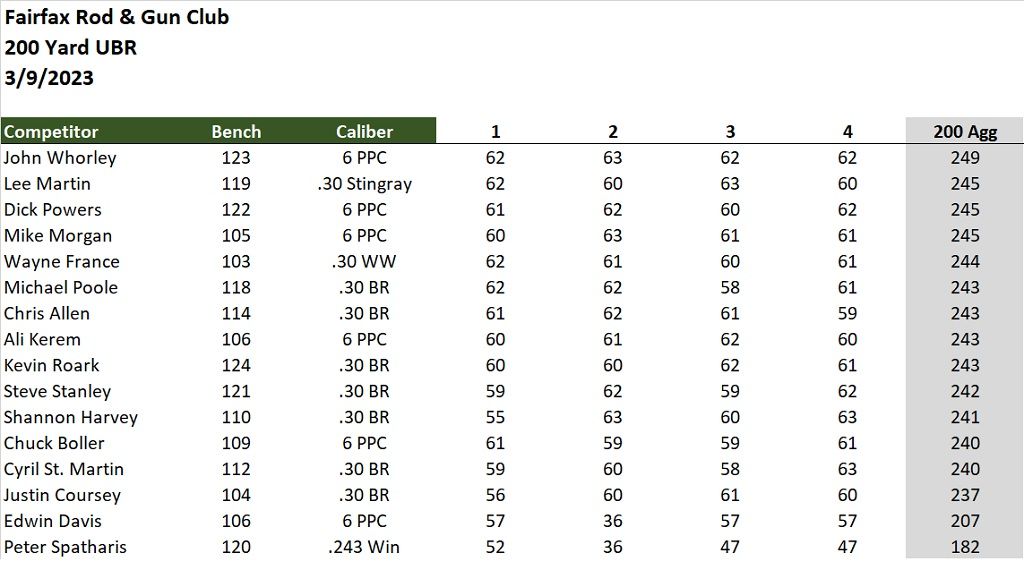 -Lee www.singleaction.scom"Chasing perfection five shots at a time" |
|
|
|
Post by Lee Martin on Apr 12, 2024 19:08:44 GMT -5
Match #193 Black Creek Gun Club – Mechanicsville, VA IBS 100 Yard VFS ______________________________________________ We had another strong turnout at Black Creek; 23 competitors in total. The forecast called for heavy wind, and it came through as promised. Lynwood Day had a wind meter which recorded 25+ mph gusts and sustained blow in the 10 – 15 mph range. When I was setting up flags, I noticed how many would spin 360 degrees, then quickly flip back the other way. Big wind is hard enough when it’s going mostly in one direction. Swirling wind on this magnitude is doubly bad. So often you hold for one condition, go to touch the trigger, and have a rapid switch push your shot into your hold. But everyone guts through it. I picked bench 15, which I haven’t shot in a while. At Black Creek, the 100-yard range is also used for trap shooting. The trap house is sunk into the ground, but the top 3 feet are exposed. The upper layer is a flat black material which amplifies mirage. Benches 14 – 16 are directly behind it. Here’s a photo of what I just described: 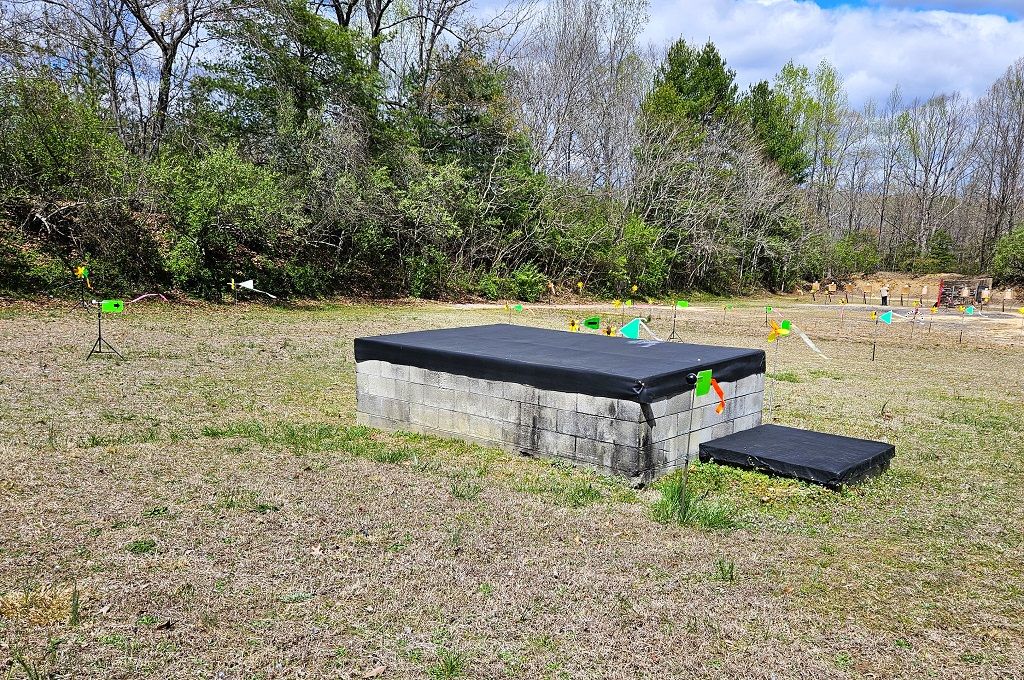 Gauging the wind, I told someone before we started that a 250-16X or 17X may win it. The conditions were that tricky. I took my time, shot let-ups, and finished with a 250-23X. That was good enough for the win. I’ve mentioned this before, but when your bullet and barrel get along, you can absolutely trust your holds. And when they’re really in harmony, the gun occasionally does things that defy physics (seem to at least). In warm-up, I shot hard left wind, hard right wind, and headwind which quartered. I never shot the brutal stuff but tested the 10 to 15 mph variety. Every time I wanted to see how much the bullet would get pushed with a center hold on the dot (which is 0.0625" in diameter). To my surprise, and possible frustration, they kept landing on top of one another on the X. It was odd and can be unsettling. Would that last as the day progressed? But throughout when trying sighters in stiff wind, the center hold worked for either left-to-right or right-to-left in the 10 mph or a bit less range. You’ll hear BR shooters sometimes talk about their bullets being more immune to wind than they should be given the conditions. Mine exhibited that last Saturday. Were the bullets exiting the barrel with slightly less yaw? Was the tune perfect? Was I getting lucky and having one condition offset the other at various points along the 100-yard span? Or maybe it was good luck from a little plastic Stingray someone gave me before the match. Who knows and who cares, right? When the gun is working, trust it.   Shannon Harvey and his dad deal in classic Corvettes. He knows my cartridge is named the .30 Stingray, so he gave me a few of these prior to the match.  -Lee www.singleactions.com"Chasing perfection five shots at a time" |
|
jwp475
.375 Atomic
  
Posts: 1,100
|
Post by jwp475 on Apr 16, 2024 14:49:25 GMT -5
CONGRATULATIONS! Lee
|
|
|
|
Post by Lee Martin on May 15, 2024 19:35:43 GMT -5
Match #194 Fairfax Rod & Gun Club, Manassas, VA IBS 100 Yard VFS I never thought we’d get wind worse than the previous match at Black Creek, but we did. The forecast called for up to 40 mph gusts and sustained winds in the 15 – 20 mph range. I didn’t see any wind meters on the line, so it was hard to say if it ever hit those figures. What I did see however were lots of targets being pulled from the backers, making for a few cease fires. It wasn’t a day for X’s. My strategy, as with others, was to just stay on the 10-ring. If I could do that, I’d have a chance. So bad were the conditions that after 3 frames at 100 yards, there were only 3 of us out of 16 that hadn’t dropped a point. Target 4 was my downfall. I was getting around the bulls pretty well and found a hold that worked once the gusts died down. Until it didn’t. Just as I went to touch the trigger, the entire middle of the field was hit with what had to be well over 20 mph wind. Just enough to move the bullet off the 10-ring. I went over to Wayne France, who was still clean, and said “Get 10’s on the last frame and the win is yours” (Ed Davis was also clean but very low on X’s). I got through frame 5 quickly when the wind became somewhat manageable. Then it picked up and I soon heard profanity from Wayne’s bench. He also dropped a point. In the end, Ed Davis was the only competitor to hit all 10’s...and he did so with a 6 PPC.  _______________________________________________________________ Match #195 Black Creek Gun Club, Manassas, VA IBS 100 Yard VFS Mild air and wind made for a pleasant day of shooting at Black Creek. There was light rain throughout, which probably kept the competitor count under twenty. I wish I had something astute to say about my performance. Simply put, I just didn’t have it. I was sick all week and am tempted to use that as an excuse 😊. Truth be told, I slept great the night before and had a ton of energy for the match. And the gun looked like it wanted to work. Test groups in the sighter box were tight. I made two tuner adjustments to see if it wanted something different, but no dice. The original setting shot the best. Tweaking and all, I kept missing X’s by a smidge on every target. I finished with a 250-17X, which was middle of the pack. But I will remember the day because Shannon Harvey got his first win. He’s been showing a lot of promise and it all came together for him. When I handed him the winner’s patch, I said it’ll be the first of many.  -Lee www.singleactions.com"Chasing perfection five shots at a time" |
|
|
|
Post by bradshaw on May 16, 2024 9:22:25 GMT -5
Lee.... as you state, once wind craters the X-count, the job resorts to herding all your ponies to the center corral. Perhaps the 6mm PPC of Edwin Davis drifted a pinch less than the .30’s to grip the ten ring. Shooters who stick around to compete when adversity assaults consistency are the shooters who learn from rough going.
David Bradshaw
|
|
|
|
Post by Lee Martin on Jun 5, 2024 19:14:37 GMT -5
Match #196 Orrington & Damariscotta, Maine The Maine Firecracker - IBS VFS 100/200/300 Yards I look forward to the Maine Firecracker more than any other match. Sure, it’s a haul but you can’t find a better bunch of folks to compete against. And the conditions make for intense shooting. This was my fourth time attending the Firecracker with Wayne France and it didn’t disappoint. The event starts with 100 yards on Saturday in Orrington, ME. As common for the region, the wind was howling. Definitely the type of air that made you weary of blowing a 9. I shot OK but missed more X’s than usual. The gun was printing tight and none of my missed X’s were hangers (meaning barely clipping the 10-ring). They’d just flick off the dot. I finished in 10th place and Wayne won the yardage with a very solid 22 X. Second place was a full 3 X’s behind him. We switched to 200 yards on Sunday, again at Orrington. The wind was a hair tamer but kept you honest. The tough thing about Maine is you rarely get one direction. It swirls. I missed one 10 ring on a hard switch at 75 yards. I was shooting right to left and held in the 9-ring at 4:00. Just as the trigger broke, the third flag flipped wildly left-to-right. That stuck the bullet exactly to my POA; namely the 9-ring. Even so, I was able to take 4th place. John Cascarino, who just made it into the NBRSA Score Hall of Fame, won the yardage. After the match, we packed-up and drove 60 miles south to Damariscotta. I’ve shot nearly all the ranges on the IBS Score circuit and nothing compares to Damariscotta. Located just a few miles off the Atlantic Ocean, the wind up there can only be described as horrific. It blows hard and flips on a dime. Flag setting at Orrington Friday afternoon, looking back at the line: .jpg) Wayne and I enjoying some of Virginia’s finest after Friday flag setting: .jpg) View from the line: .jpg) .jpg) IBS Treasurer Don Cameron at the bench: .jpg) Monday was 300 yards and the weatherman called for 5 mph wind. No one believed that would come to be and they were right. It was more like 15 mph and swept through in every direction. You’d see left-to-right, right-to-left, and quartering in and out...and that was all once. I got off to a good start but was eaten alive on target #3. Even after 12 to 15 sighters, I kept leaking out into the 9-ring. The problem was, by the time I fired a sighter and came up to a record bull, the wind was totally different. It didn’t matter how fast I tried to get off the two shots. I was caught again and again. Target #3 aside, I placed well enough to take 6th in the Grand Agg. Randy Javis won the 300 with his HV and took 2nd with his LV. The guy is a machine. Flag setting Sunday evening at Damariscotta: .jpg) View of from the line in light rain: .jpg) Top 10, grand agg results: 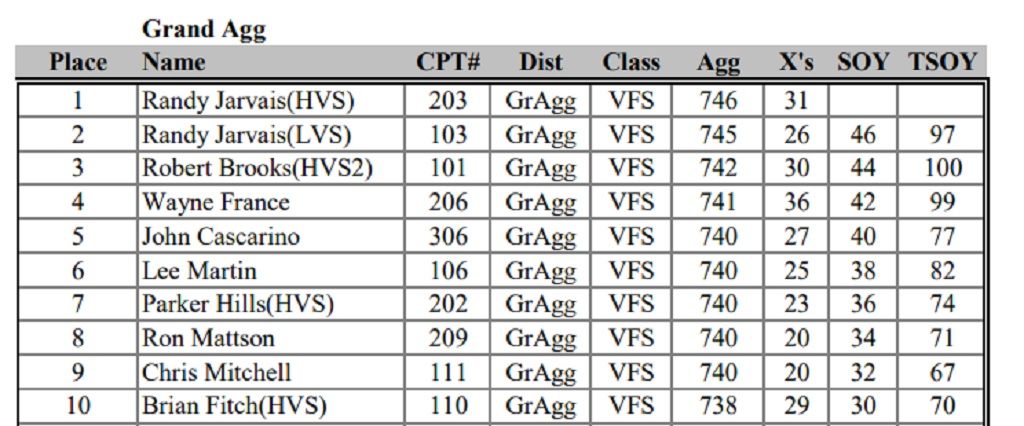 The highlight of the weekend for me came thanks to Brian Fitch. Brian is an accomplished Hunter Class competitor and told me I was shooting his new Hunter rifle. He would run with his old Hunter rig. I probably haven’t discussed Hunter Class to this point, but the rules are simple. Varmint Hunter class rifles must have the following: 1) Scopes no higher than 6X magnification 2) Total weight cannot exceed 10 lbs 3) The stock forend must be 2.25” or less 4) The action must have a magazine capable of housing at least one cartridge Brian’s new rifle was in .30 BR and done on a Kelbly Kodiak action. The barrel was a Hart and the stock was by McMillan. The real limiting factor is the 6x scope. Even at 100 yards, you can’t see the bull rings and you can’t even see the bullet holes. For that reason, Hunter shooters attach a spotting scope the bench for visual aid. I got off on the wrong foot at 100 yards and dropped a few points. Then Brian asked me if the parallax was correct. I figured he had set it already, and he did. The problem was it was adjusted for his eyes. After testing it, I noticed the reticle was moving all over the place. Once positioned for my eyes, my scores improved. Sunday at 200 yards I was actually leading the pack of six Hunter shooters after three targets. I couldn’t hold that lead however after flubbing targets 4 and 5. Monday at 300 yards was even more humbling. It’s hard to describe what a 1.5” circle looks like at 300 yards through a 6X scope (or better put, what it doesn’t look like). You can’t hold off rings with that magnification. Instead, you simply try to quarter the bull and pray. I finished 5th out of 6 in the Hunter Class Grand Aggregate. I had a blast shooting his rifle and was encouraged. The Hunter rifle Brian Fitch loaned me for the weekend: .jpg) -Lee www.singleactions.com"Chasing perfection five shots at a time" |
|
|
|
Post by Lee Martin on Jun 12, 2024 18:42:35 GMT -5
Match #197 Black Creek Gun Club, Mechanicsville, VA 1st Annual Kay C. Young Memorial - IBS VFS 100/100 Yards Kay C. Young built and owned Black Creek Gun Club from the late 1960’s until his death last September at age 88. Kay C was a gentleman in the truest sense and helped a lot of us shoot better. He was instrumental in the development of rimfire benchrest accuracy and contributed greatly to centerfire as well. Five years ago, his age was preventing him from continuing our IBS matches at Black Creek. I offered to take over as match director and not only did he say yes, but he also assisted me tremendously. For these reasons I’ve decided to make my June 100/100 yard agg match a memorial to Mr. Young. Two weeks ago was the first annual event and we had beautiful weather and a strong turnout. My shooting was mediocre at best. The gun showed a lot of promise, with sighter groups not only on the X, but tearing ragged one-hole prints across three shots. That precision didn’t translate as well as I hoped to record bulls. The wind was mild, but the mirage was problematic. All day I felt I was guessing on my POA. Sometimes it worked, sometimes it didn’t. Jason Owens took the first match with an outstanding 250-22X. We then rotated eight benches and went into match 2. I continued to drill 2 or 3 X’s in a row, then miss the next by a little. On target #3, I noticed my ‘table manners’ were lacking. In short, I was letting the gun get too much of a run in free recoil. I tightened that up on targets 4 and 5 and immediately saw improvement. It was too late to make a run for the win, but I still got 4th in the agg. Wayne France won the second match, and Jason Owens got the Grand Agg. .jpg) Me handing Jason Owens the Grand Agg plaque: .jpg) .jpg) .jpg) _________________________________________________________________________ Match #198 Fairfax Rod & Gun Club, Manassas, VA IBS 100 Yard VFS Warm weather and switchy wind were upon the 11 shooters who made it to Fairfax. Light turnout because a few regulars decided to shoot a 200/300 yard match in Staunton, Virginia. I paid particular attention to my gun handling, to not repeat the excessive free recoil I allowed the week prior at Black Creek. It paid dividends. Despite fast wind shifts, I was able to stay on the X most of the day and earned the win with a decent 250-21X score. The four I missed weren’t by much.  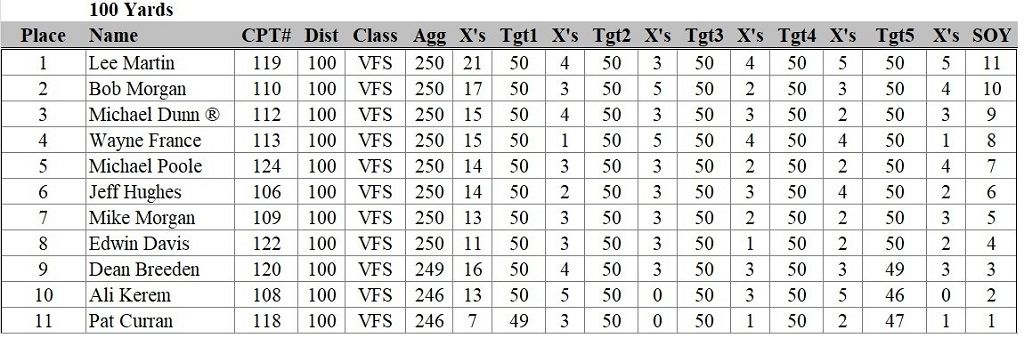 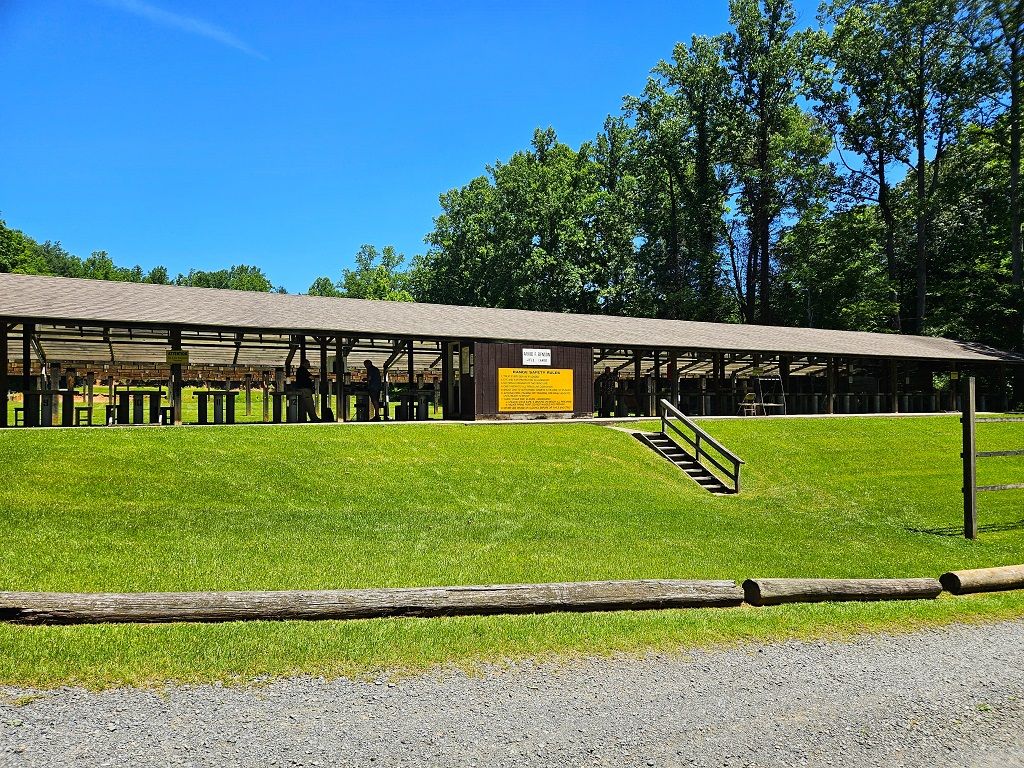 -Lee www.singleactions.com"Chasing perfection five shots at a time" |
|
jwp475
.375 Atomic
  
Posts: 1,100
|
Post by jwp475 on Jun 13, 2024 6:29:15 GMT -5
Congratulations!
|
|
|
|
Post by Lee Martin on Jun 27, 2024 18:37:05 GMT -5
Match #199 Rattlesnake Ranch Wildlife Club, Dover, NC IBS VFS 100/200/300 Yards The Rattlesnake Wildlife Club is a new range which began hosting IBS events in 2023. The facility is equipped with 100, 200, 300, and 600 yard target lines. I wanted to make it to the inaugural Score match last summer but was unable to attend. I circled the June ’24 event the minute the schedule was set. This would be a 100/200/300 yard competition across two days. The Rattlesnake is a pretty unique club. The range itself is cut out of the middle of a tobacco farm. The clubhouse, where folks load and clean rifles, was an old tobacco barn they converted on the inside. They left the exterior as-is, which shows years of character. I heard a lot about tricky wind and nasty mirage before making the trip. The Rattlesnake lived up to the hype. It was well over 90 degrees both days and the mirage made target rings and even bullet holes hard to see. View of 200 yards from the bench: .jpg) Tobacco fields lined both sides of the range: .jpg) Looking back at the firing line while setting flags: .jpg) View of the converted tobacco barn, inside and out: .jpg) .jpg) .jpg) The range is appropriately named. The region is home to Eastern Rattlers: .jpg) We began Saturday with 200 yards first. I decided to take my back-up .30 Stingray, since it’s equipped with a 50X March scope (my homebuilt action wears a 40X). The extra 10X gives a better view at 300 yards, but that comes at the expense of more impactful mirage. All that aside, the gun shot well at 200 and I was able to take 7th out of 28 competitors. I dropped a couple of points, but so did everyone else. In fact, no one stayed clean at 200. That afternoon, we rotated 7 benches, moved flags, and shot 100 yards. Immediately points starting to fall. I was able to stay clean and hit all 10’s, but X’s were hard to come by. The wind had picked up and the mirage got worse that afternoon (and it was bad to start). Out of 28 shooters, only 9 of us managed to pull off a 250. Pretty unheard of considering the talent in attendance. But again, this speaks volumes to the conditions. I took 6th out of 28 at 100. Good friend Chris Allen working 200 yards: .jpg) My gun on the line for 300 yards: .jpg) 300 yards proved to be the toughest shooting on the weekend; and it wasn’t simply due to the distance. The mirage moved reticles all over the target. Most of the time, there were 1 to 2 rings of bounce. Even more unnerving was the wind push. It was a left-to-ring dominant blow which bent bullets WAY more than the flags and probes suggested. At times, the tails would be at 4:00 to 5:00, which isn’t bad and the probe we set at 175 yards was a mark or two right. Crazy thing was, the wind pushed the bullet 4 to 5 inches right; necessitating POA’s in the 6 or 7 ring to land 10’s. That worked until it didn’t. On multiple occasions, I’d shoot a sighter which showed a 7-ring hold to get the mothball. I’d come up, fire, and it would land left in the 9. Other times, that 7-ring sighter to the left still took shots into the 9 on the right side of the 10-ring. Frustrating to say the least, but we all muddled through it. I finished 15th at 300, which is ho-hum. I was 10th in the grand agg. My good friend Chris Allen, who I traveled with, took 9th. And Virginia shooter Dick Powers finished 3rd in the grand. John Bosley from Maryland was 2nd, and Todd Paseur from South Carolina won the whole thing. .jpg) .jpg) As with all matches run by Jim Cline, the event couldn’t have played out smoother. And the Rattlesnake club members who assisted were very gracious. Tough place to shoot, but a range I really enjoyed. I will compete there in the future. -Lee www.singleactions.com"Chasing perfection five shots at a time" |
|
|
|
Post by bradshaw on Jun 28, 2024 7:11:51 GMT -5
Lee’s story sets the bar for tracking a rifle's performance, the performance of a couple of rifles, and for tracking the performance of a marksman imperative to translating mechanical accuracy to the target. Bench Rest competition strives to resolve accuracy on target through the elimination of variables, beginning with construction of the rifle. Incorporating its optical sight. The bullet must cross a minefield of atmosphere between muzzle and target; this is where the shooting happens. To steer multiple shots into the measure of the bore axis @ 100 yards, and to attack that same measure @ 200, even 300 yards, requires the man or woman at the helm to ride the bullet through this intervening turbulence.
From inception of this report to this moment we see that a rifle by itself may shoot a better “weather report.” Whereas, with a sharpshooter at the helm, groups may better reflect intrinsic accuracy of the rifle.
David Bradshaw
|
|
|
|
Post by Lee Martin on Jul 2, 2024 19:41:50 GMT -5
6 PPC – Random Stuff __________________________________________________ I’m starting to shoot my 6 PPC more and hope to use it in a West Virginia 100/200 yard match in three weeks. A few changes I’ve recently made to the set-up include (and like all things BR, I’m documenting it here for future reference in case I forget): BARREL THREADS - The gun itself has the action glued into the stock. This lessens weight by eliminating pillars and provides for dead rigid bedding contact. The only downside is, you can’t test the action on the barrel when threading the tenon in a lathe. In the past, I’ve used the 3-wire method to gauge thread depth, but one time I got lazy. Going off the compound feed alone, I dialed the same number I did on the prior barrel. After pulling the completed barrel, I found it was tight screwing into the action. Which isn't good. I want my threads to be a tad loose, with all of the load to be on the main ring. This forced me to re-indicate the barrel, re-time the threads against the lathe gearing, and go in a few of thousandths deeper. It was a real pain. So, for Christmas my dad bought me a thread micrometer. These are handy for measuring thread depth when you can’t test the job on its mate; and it's much quicker than the 3-wire method. The mic comes with different points to accommodate various TPIs. My light varmint 6 PPC with glued-in action:  The thread micrometer: 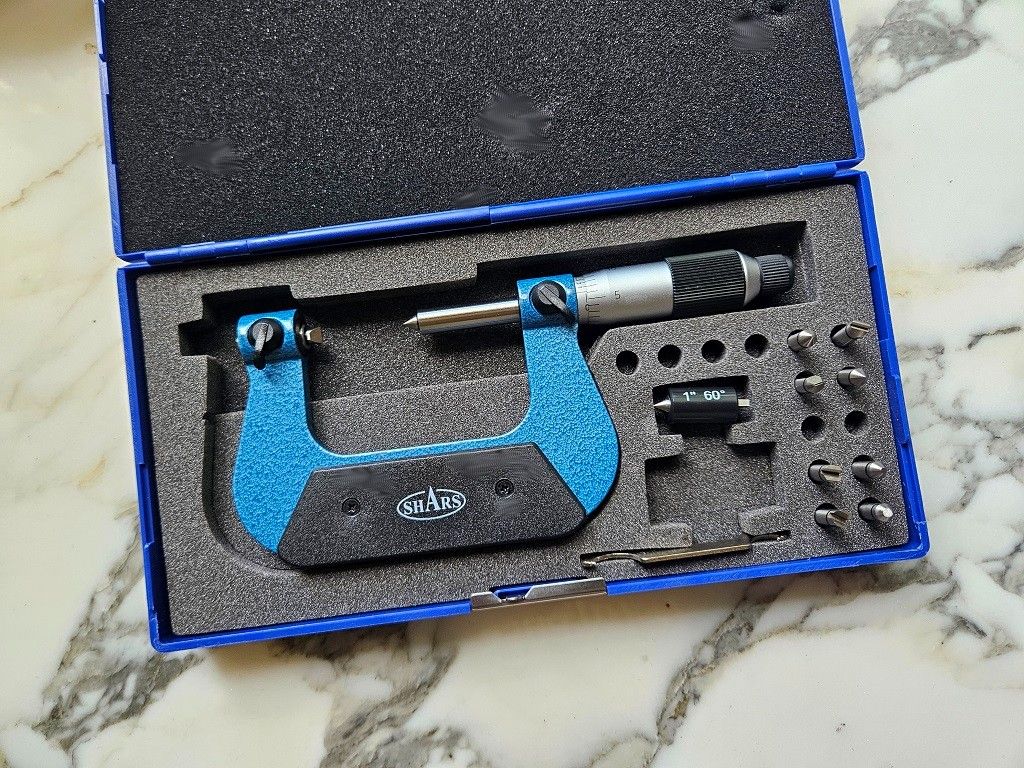 NECK TO CHAMBER CLEARANCE NECK TO CHAMBER CLEARANCE – a lot has changed in benchrest loading techniques over the years. Gone are the days when folks would just shoulder bump on sizing. Now we full-length size after every firing. The result is longer case life. Another trend has been to move away from extremely close tolerances for neck clearance. Hall-of-fame BR shooter Jack Neary probably has as much to do with this as anyone. About 15 years ago, he started preaching “thin-to-win”. Basically, he advises thinning neck thickness for more clearance. In the old days, guys ran 0.001” total clearance or less. I cut a tight 0.0015” and have been wanting to go larger. Recently, I turned all my PPC brass from 0.0095” wall thickness to 0.0090”. On a 0.2640” chamber, this moves clearance from 0.0015” to 0.0025” (loaded round of 0.2625” vs the new 0.2615”). The idea is the added gap promotes more consistent bullet release. I’ll see if it shows up on target, but at a minimum it won’t degrade precision. Neck wall thickness is measured with a ball micrometer:  A box of PPC’s re-turned to 0.0090”. Two call outs on the lid. The 0.090” should read 0.0090”, which is neck wall thickness. Total misprint on my part. Secondly, the 110.7 – 111.0 denotes pre-turned case weights. I used to sort brass by weight but gave up on the practice. Truth be told, the variation could well be in the neck you’re about to turn. And if it isn’t, that too doesn’t matter. With Lapua brass, weight variations within the same lot are inconsequential. 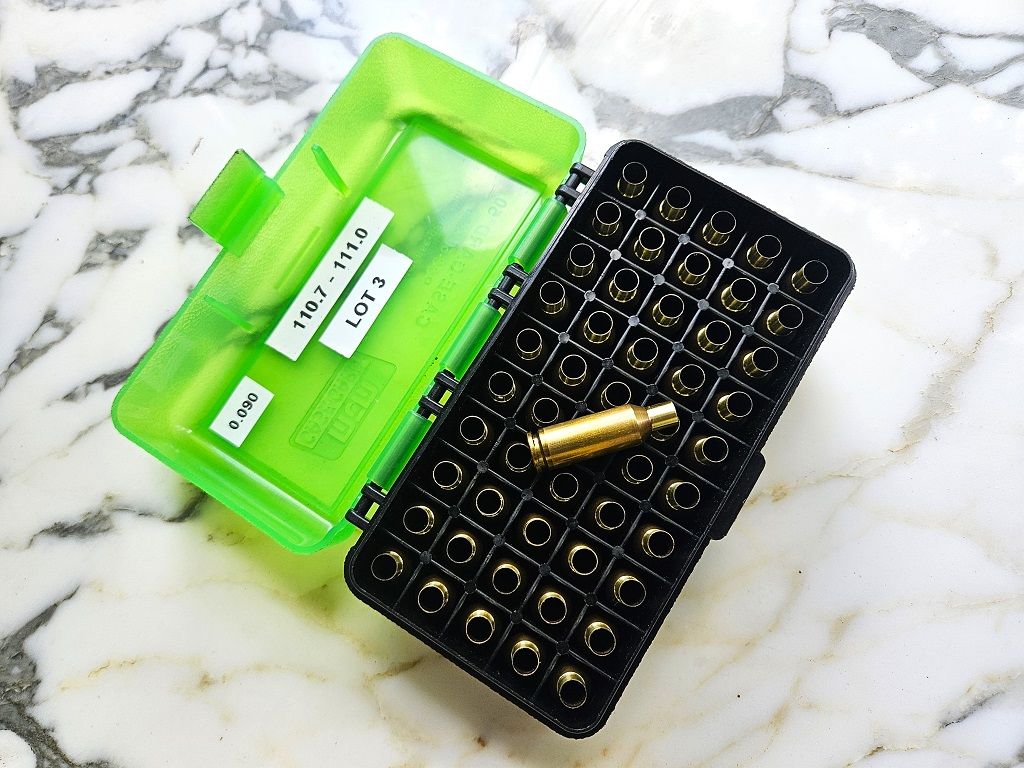 However, I did have to adjust my AMP annealer. Since I thinned the necks, I had to burn up a test case to get the correct code for the 0.0090” batch. The 0.0095”s, given the same lot, were 131. These analyzed at 130. Pretty small change really. The test case I burned up in the annealer: 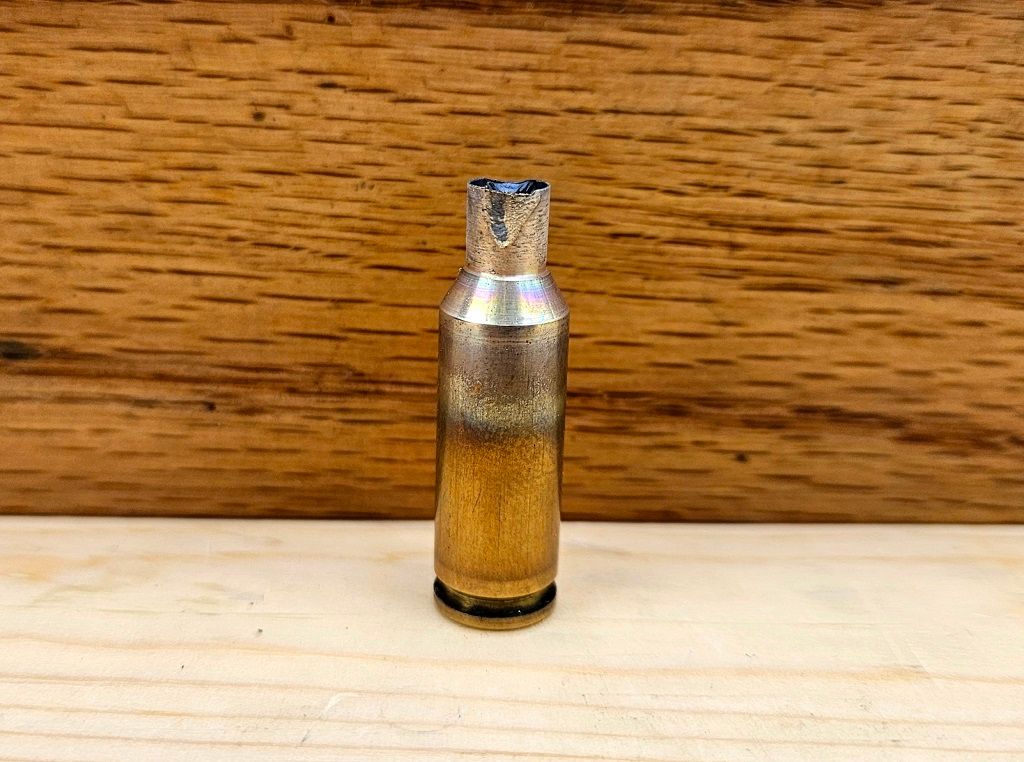 BULLETS BULLETS – For the past 8 years, I’ve made my 8.5 ogive 6mm’s on Hines jackets. They’ve shot remarkably well, and I still have around 10,000 on-hand. But a local shooter, who I make bullets for, needed some 6mm’s and I’ve exhausted my Hines jacket supply. Also, Hines isn’t doing small runs anymore and I’m unwilling to fill their 50,000 piece minimum. That left J4’s, which have been used in short-range BR since the 1960’s. Whereas the Hines were 0.820”, the J4’s are 0.825”. Surprisingly, both are nearly identical on weight. The Hines are a bit harder and aren’t tapered as much on the inside. The J4’s are softer and have more I.D taper: An old drawing of the J4 6mm jacket: 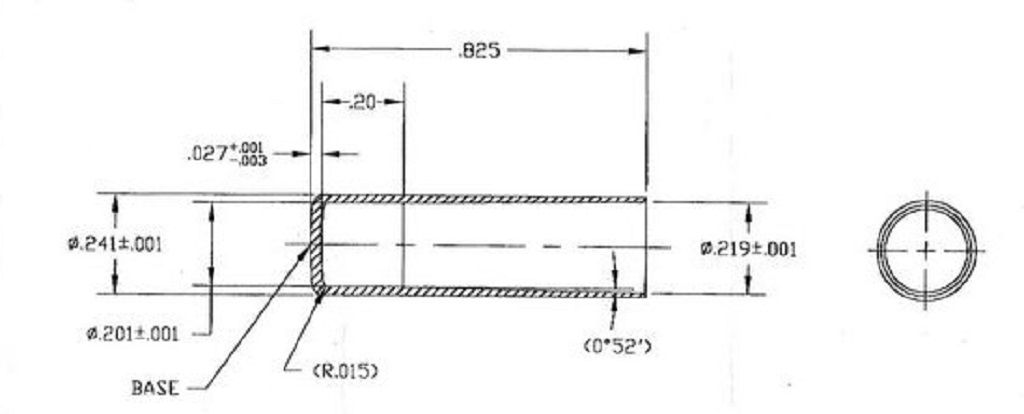 The added internal taper made me change from a 0.2120” core seat punch to a 0.2115”. Every 4th or 5th jacket wasn’t coming off the punch with 0.2120”. Moving to a 0.2115” eliminated that completely and gave the proper hairline of “bleed by” on the core’s top edge. Most importantly, they expanded up to the final O.D. of 0.2433”. When you point bullets, the shank needs to already be a full dimension. And here’s where the tinkering came in. With my .30 caliber bullets, I used to make them with a bearing surface length of 0.327”. Bearing surface is measured from the base of the bullet to where the ogive contacts the lands. With a .30-caliber barrel, that’s around the 0.300” diameter of the bullet. They shot plenty good, but Wayne France told me what Hal Drake taught him years ago (Hal was a phenomenal benchrest shooter from Virginia. Sadly, he passed away in 2023 at age 53). Anyhow, Hal found his bullets were easier to tune and shot better with the longest bearing surface you could make. He would basically back the die out until they just started to stick on the ejection pin. Then down about a thou or two and lock it to where they’d cleanly eject. I did the same on my .30’s in 2020 and went from 0.327” to 0.339”. And boy did the bullets wake up, particularly at 200 yards and beyond. I decided to do the same with my 6mm’s going forward. Bearing surface is measured using a caliper mounted gauge my dad made. It has inserts which approximate the land diameter for caliber. The .30 insert is 0.300”, the 6mm is 0.237”. Top view of the 0.237” insert: 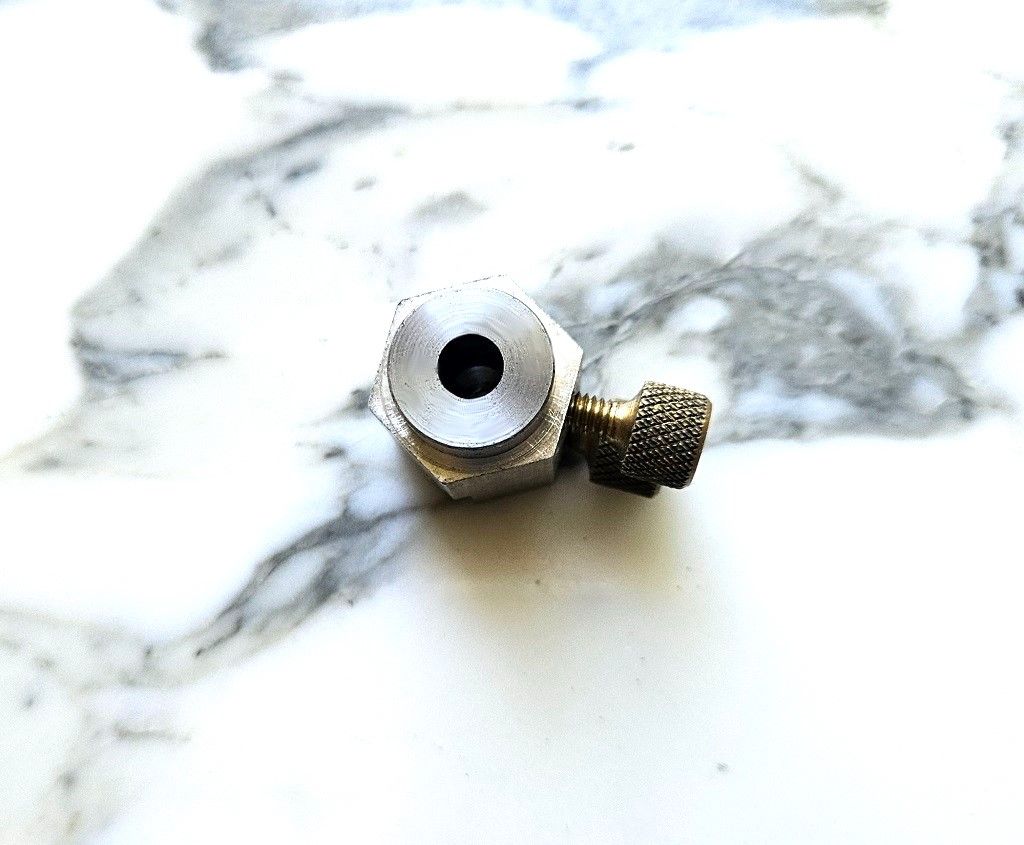 Attached to the caliper: 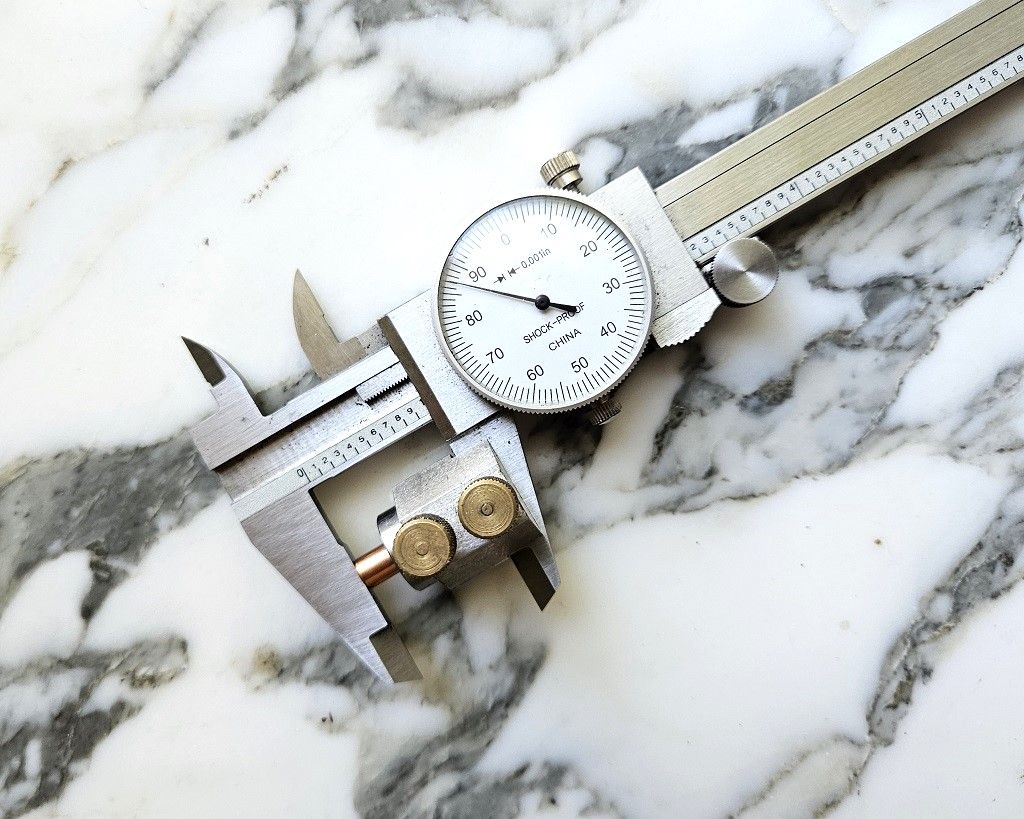 The gauge without a bullet measures 0.679”. My Hines made 6’s measure 0.969”. Bearing surface is 0.969” – 0.679” = 0.290”. I began backing my point die out until they had to be flicked off the ejection pin on upstroke. From there I screwed the die back down, taking 0.001” off the bearing surface and they dropped beautifully. These measure 0.987”, yielding a bearing surface of 0.308”; a full 0.018” longer than what I previously formed. We’ll see how these do on paper, but I suspect they’ll perform as good or better. Longer bearing surface does increase the meplat diameter a miniscule amount, which won’t matter for short-range work out to 300 yards. My 67 grain 6mm on Hines (left), the new longer bearing surface J4’s (right). If you look carefully, you'll notice the taller shank height on the J4. 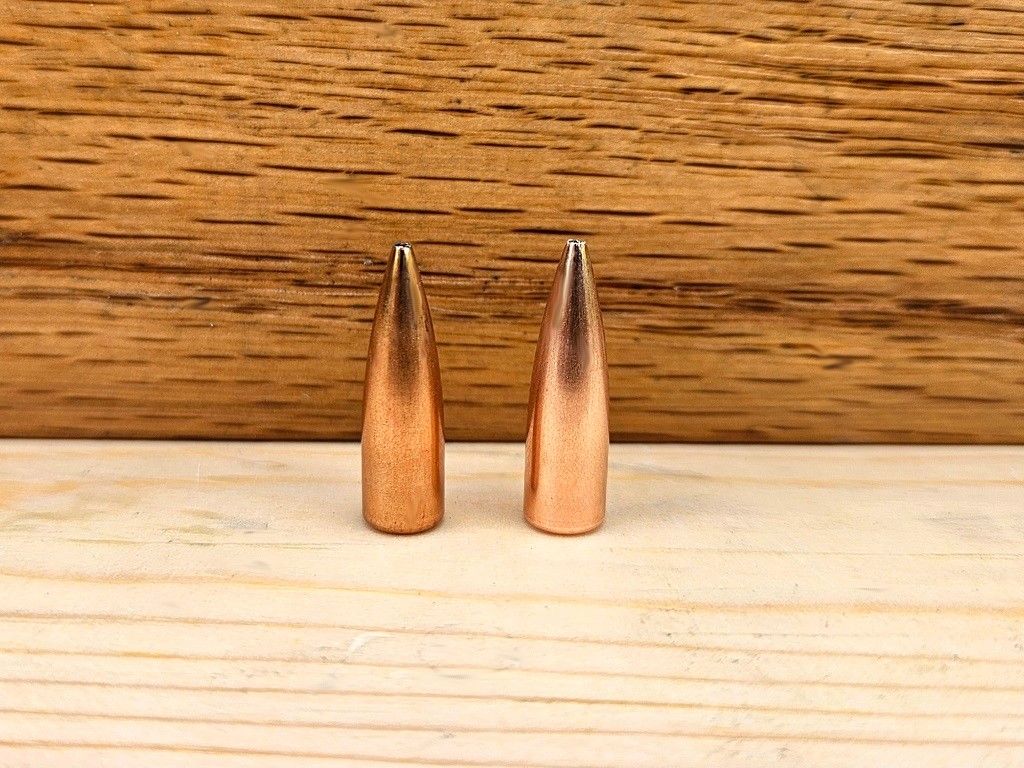 -Lee www.singleactions.com"Chasing perfection five shots at a time" |
|
|
|
Post by Lee Martin on Aug 1, 2024 18:24:25 GMT -5
Match #200 Black Creek Gun Club, Mechanicsville, VA IBS VFS 100 Yards Match number 200. If you told me in July 2016 when I entered my first competition, I’d have 200 under my belt in exactly 8 years, I wouldn’t have believed it. But it’s been a fun journey and I look forward to the next 200 (God willing). Temperatures were 99 degrees with a heat index of 106. Fourteen competitors braved the weather and had an enjoyable time. The wind was mild and surprisingly, the mirage wasn’t too bad. Chris Allen had it working and won with 23 X’s. He missed a Screamer (24 X’s) by a few hundredths. My gun showed up good in the sighter box all day. Unfortunately, that didn’t translate as well to record bulls. I had five that needed reticled and none made an X. I kept missing by a hair…which caused me to pull mine out. There are days when you’re on and days when you’re a half step off. This match was the latter for me. 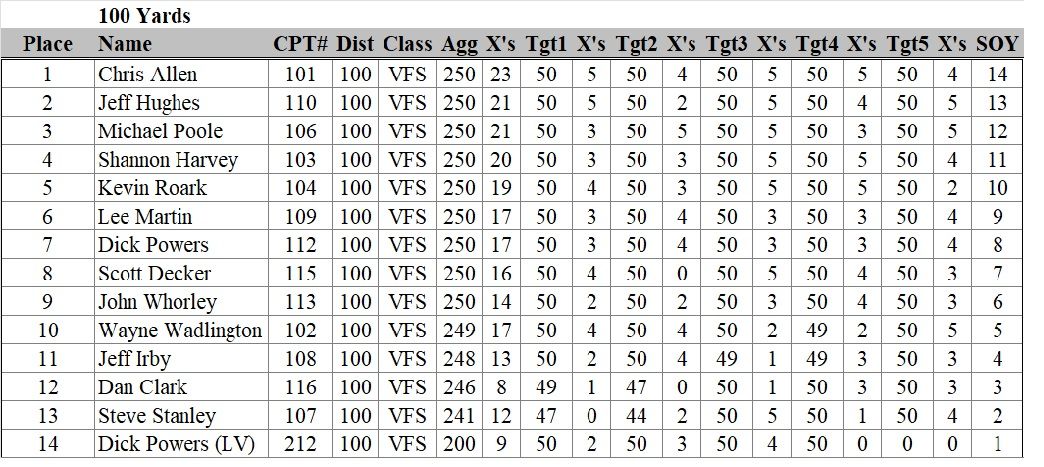 ___________________________________________________ Match #201 Fairfax Rod & Gun Club, Manassas, VA IBS VFS 200 Yards Brutal heat once again kept a few competitors at home. Fairfax dealt us mild conditions, which at that range can be problematic. For whatever reason, you’re able to trust your holds more when there’s a bit of breeze. Only two people stayed clean at 200 yards. I almost was the third until I got caught on a switch. Holding 4:00 on the 10-ring with good results, on one shot I pulled the trigger just as the wind flipped from right-to-left to left-to-right. I stuck the bullet in the 9-ring, missing by a smidge. I was still able to finish in the money however with 3rd place.  __________________________________________________ Match #202 Issac Walton League, Leetown, WV UBR VFS 200/100 Yards Leetown was a day of live and learn for me. As you may recall, I recently thinned my 6 PPC brass from 0.0095” wall thickness to 0.0090”. The thought was a little more clearance could give better bullet release. More on that later. We started at 200 and my 6mm got better with every target. I was prepared to move the tuner if needed, but the gun stayed in tune for the entire yardage. Test 3-shot groups were in the high 2’s and low 3’s. Which is phenomenal for 200 yards. I stayed close to Michael Poole throughout but couldn’t quite catch him. He took 1st, I got 2nd at 200. But my gun seemed to be getting stronger as the day went on. Maybe I was just getting reacclimated to it. I hadn’t shot the rifle in competition for a year. My hope was to take a stab at winning the whole thing with a solid showing at 100. Then we moved to 100 yards and disaster struck. Three of the first four shots I took blew the necks clean off the brass. I used a bronze brush on a rod to clear them from the chamber. My day was done, and I was left scratching my head. The box I shot in the morning was prepped the same way and even had more rounds on it. Both were annealed, both loaded with the same charge, etc, etc. It didn’t take long for me to figure out what I did wrong. My neck tuner is set up to cut new .220 Russian Lapua which has been mandrel expanded to 6mm. That brass measures a bit over 1.500”. The brass I re-turned to 0.0090” was fire-formed and trimmed to a final length of 1.490”. I should’ve adjusted the cutter stop to account for the shorter cases. By not doing so, the cutter went at least 0.10” deeper into the shoulder. This thinned the junction too much and they when flying under pressure. I know better than to overlook something this silly. Now how the box used at 200 yards held up is beyond me. Either way, they're now relegated to the scrape pile. Both lots have at least seven firings on them prior to re-turning. I got some life out of them. 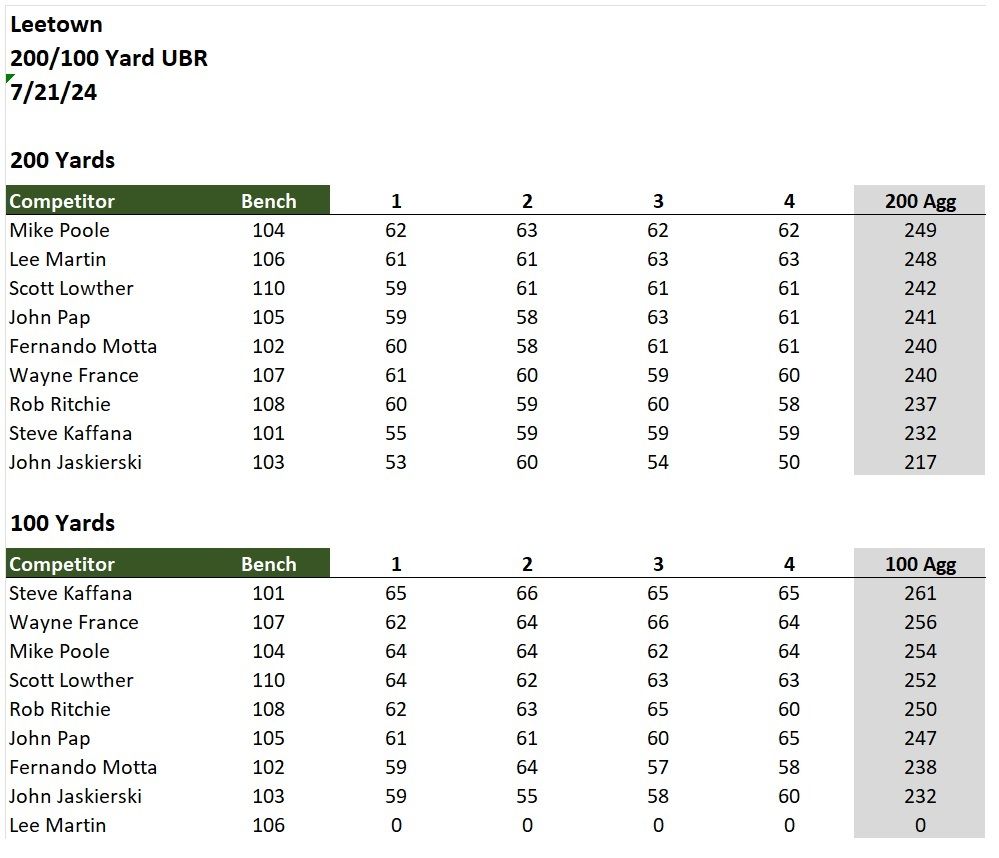 Left-to-right: blown neck, case from 200 yards that survived but clearly is cut too far into the shoulder, and my old PPC brass at 0.0095” with the neck turned to the correct position: 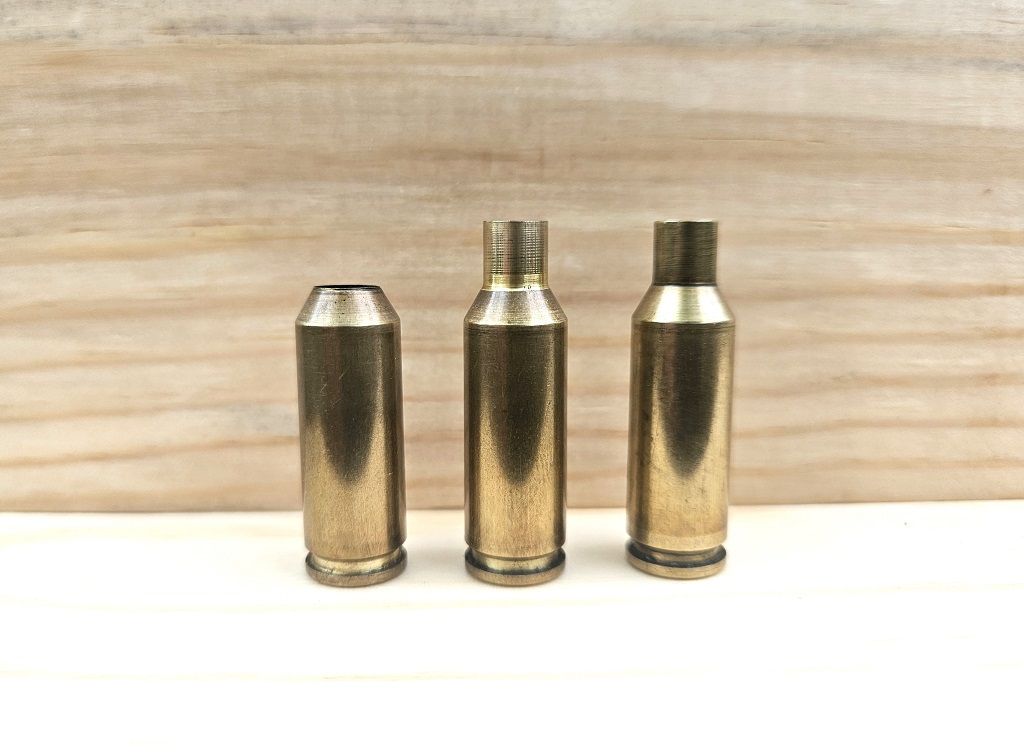 My 6 PPC on the bench: 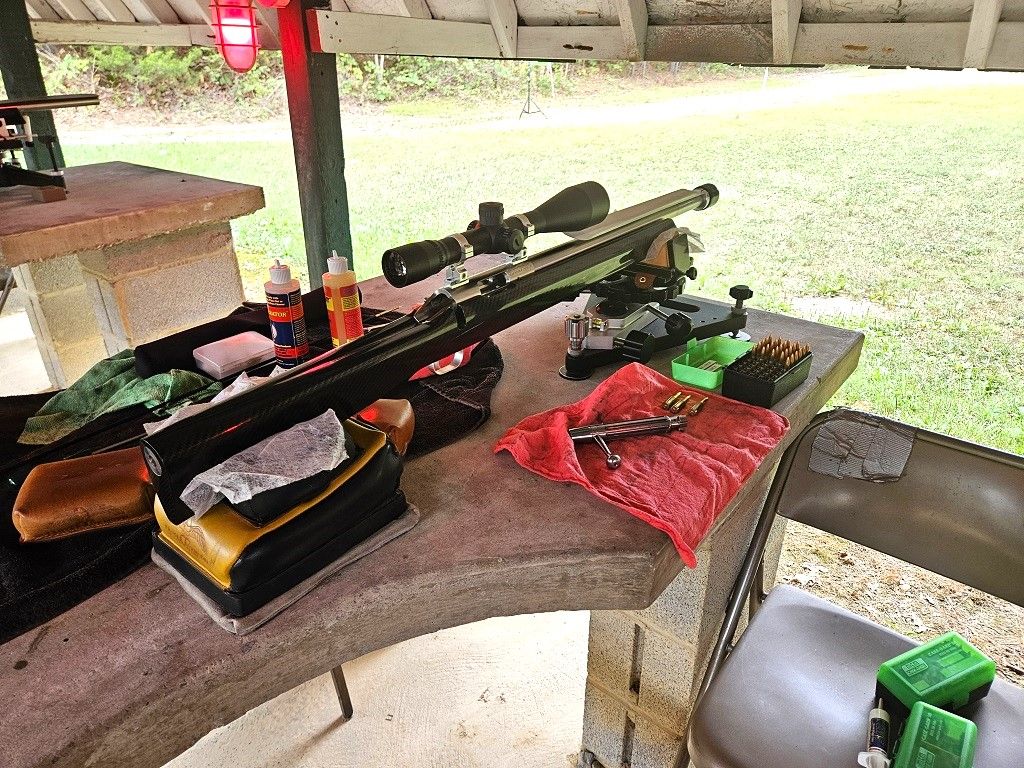 The wailing wall: 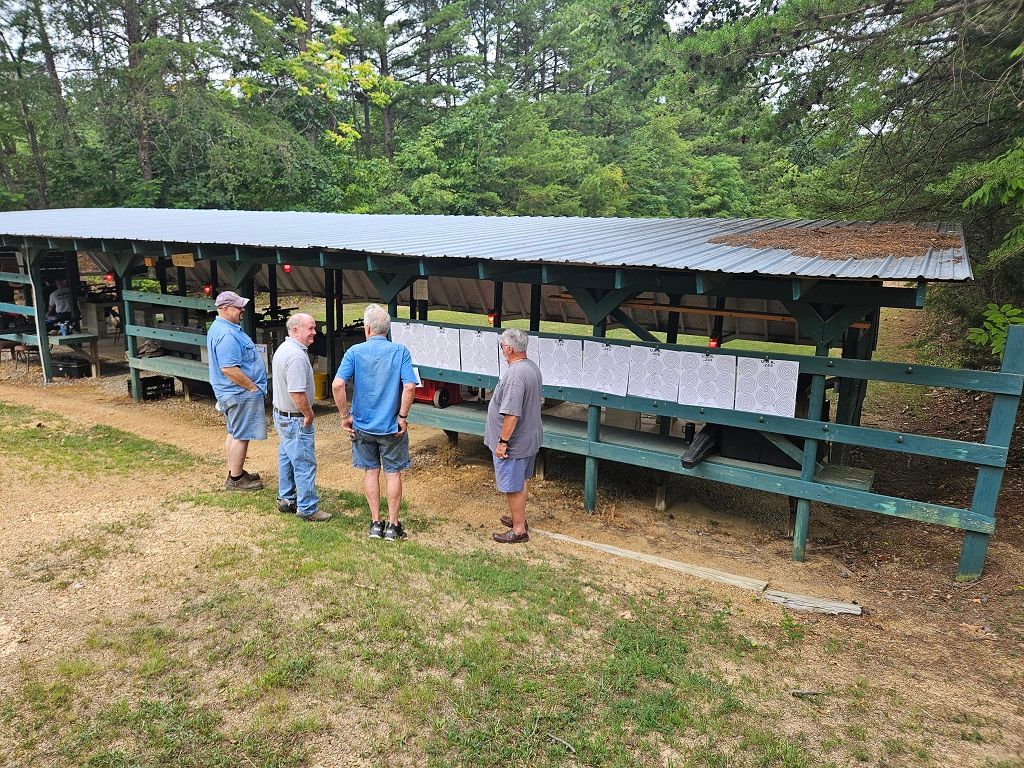 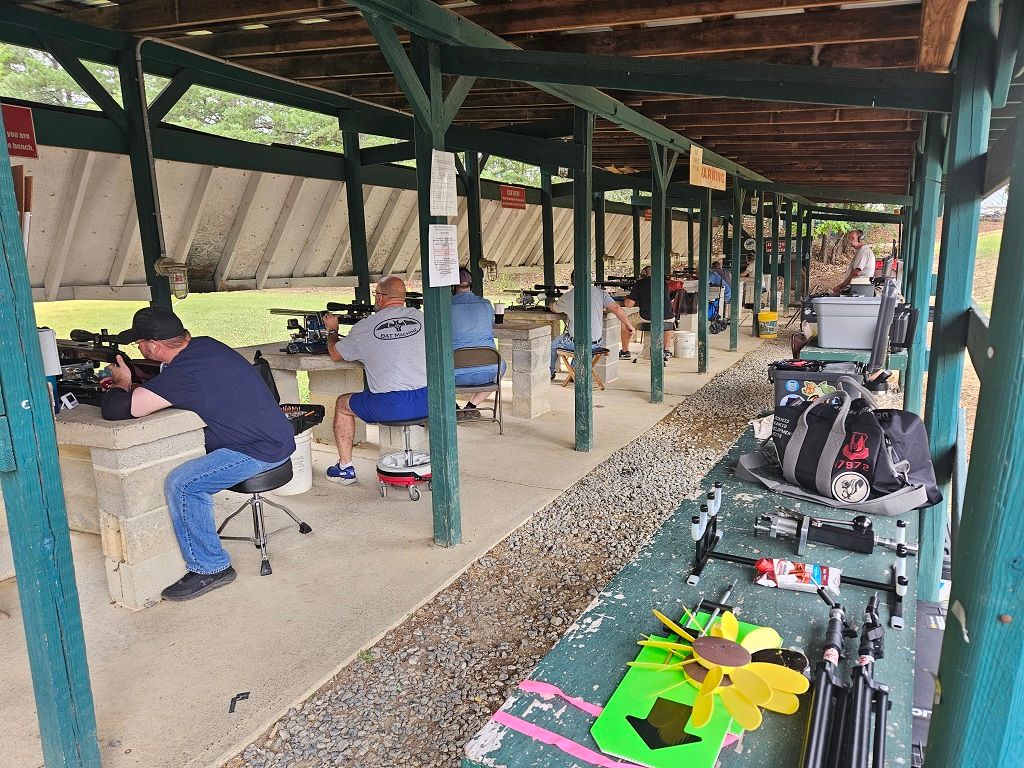 Wayne France right, Rob Ritchie left: 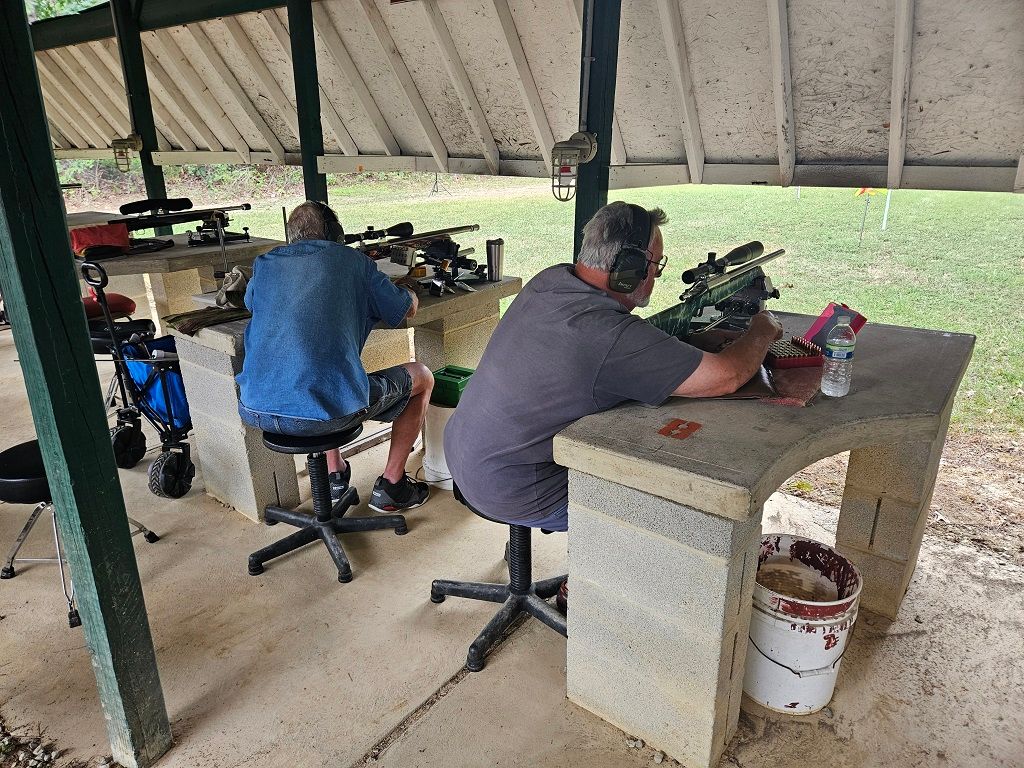 Wayne cleaning his gun after the match:  |
|




















.jpg)
.jpg)
.jpg)
.jpg)
.jpg)
.jpg)
.jpg)

.jpg)
.jpg)
.jpg)
.jpg)
.jpg)



.jpg)
.jpg)
.jpg)
.jpg)
.jpg)
.jpg)
.jpg)
.jpg)
.jpg)
.jpg)
.jpg)

















